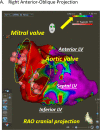Cardiac radioablation in the treatment of ventricular tachycardia
- PMID: 34646951
- PMCID: PMC8498093
- DOI: 10.1016/j.ctro.2021.02.005
Cardiac radioablation in the treatment of ventricular tachycardia
Abstract
Cardiac radioablation with SBRT is a very promising non-invasive modality for the treatment of refractory VT and potentially other cardiac arrhythmias. Initial reports indicate that it is relatively safe and associated with excellent responses, particularly in reduction of ICD-related events, need for anti-arrhythmic medications, and resulting in significantly improved quality of life for patients. Establishment of objective criteria for candidates for cardiac radioablation will accelerate the adoption of this important radiation therapy modality in the treatment of refractory VT and other cardiac arrhythmias in the coming years. In addition, in order to develop more prospective safety and efficacy data, treatment of patients should ideally be performed in the context of clinical trials or prospective registries at, or in collaboration with, experienced centers. Taken together, the future of cardiac radioablation is rich and worthy of further investigation to become a standard treatment in the armamentarium against refractory VT.
Keywords: Cardiac arrhythmias; Cardiac mapping; Cardiac radioablation; SBRT; Ventricular tachycardia.
© 2021 Published by Elsevier B.V. on behalf of European Society for Radiotherapy and Oncology.
Conflict of interest statement
The authors declare that they have no known competing financial interests or personal relationships that could have appeared to influence the work reported in this paper.
Figures





Similar articles
-
Stereotactic arrhythmia radioablation for refractory scar-related ventricular tachycardia.Heart Rhythm. 2020 Aug;17(8):1241-1248. doi: 10.1016/j.hrthm.2020.02.036. Epub 2020 Mar 6. Heart Rhythm. 2020. PMID: 32151737
-
STRA-MI-VT (STereotactic RadioAblation by Multimodal Imaging for Ventricular Tachycardia): rationale and design of an Italian experimental prospective study.J Interv Card Electrophysiol. 2021 Sep;61(3):583-593. doi: 10.1007/s10840-020-00855-2. Epub 2020 Aug 27. J Interv Card Electrophysiol. 2021. PMID: 32851578 Free PMC article. Clinical Trial.
-
Stereotactic radioablation for the treatment of ventricular tachycardia: preliminary data and insights from the STRA-MI-VT phase Ib/II study.J Interv Card Electrophysiol. 2021 Nov;62(2):427-439. doi: 10.1007/s10840-021-01060-5. Epub 2021 Oct 5. J Interv Card Electrophysiol. 2021. PMID: 34609691 Free PMC article. Clinical Trial.
-
Stereotactic radioablation for ventricular tachycardia.Herzschrittmacherther Elektrophysiol. 2022 Mar;33(1):49-54. doi: 10.1007/s00399-021-00830-y. Epub 2021 Nov 26. Herzschrittmacherther Elektrophysiol. 2022. PMID: 34825951 Review. English.
-
Stereotactic Arrhythmia Radioablation Treatment of Ventricular Tachycardia: Current Technology and Evolving Indications.J Cardiovasc Dev Dis. 2023 Apr 17;10(4):172. doi: 10.3390/jcdd10040172. J Cardiovasc Dev Dis. 2023. PMID: 37103051 Free PMC article. Review.
Cited by
-
Ventricular Tachycardia Catheter Ablation: Retrospective Analysis and Prospective Outlooks-A Comprehensive Review.Biomedicines. 2024 Jan 24;12(2):266. doi: 10.3390/biomedicines12020266. Biomedicines. 2024. PMID: 38397868 Free PMC article. Review.
-
Case Report: Treatment Planning Study to Demonstrate Feasibility of Transthoracic Ultrasound Guidance to Facilitate Ventricular Tachycardia Ablation With Protons.Front Cardiovasc Med. 2022 May 4;9:849247. doi: 10.3389/fcvm.2022.849247. eCollection 2022. Front Cardiovasc Med. 2022. PMID: 35600462 Free PMC article.
-
Cardiac Arrhythmias in Patients Treated for Lung Cancer: A Review.Cancers (Basel). 2023 Dec 6;15(24):5723. doi: 10.3390/cancers15245723. Cancers (Basel). 2023. PMID: 38136269 Free PMC article. Review.
-
Deep learning-based ultrasound transducer induced CT metal artifact reduction using generative adversarial networks for ultrasound-guided cardiac radioablation.Phys Eng Sci Med. 2023 Dec;46(4):1399-1410. doi: 10.1007/s13246-023-01307-7. Epub 2023 Aug 7. Phys Eng Sci Med. 2023. PMID: 37548887 Free PMC article.
-
Abdominal compression as motion management for stereotactic radiotherapy of ventricular tachycardia.Phys Imaging Radiat Oncol. 2023 Oct 7;28:100499. doi: 10.1016/j.phro.2023.100499. eCollection 2023 Oct. Phys Imaging Radiat Oncol. 2023. PMID: 37869475 Free PMC article.
References
-
- Motté G., Laine J.F., Slama M. Physiopathology of ventricular tachyarrhythmias. Pacing Clin Electrophysiol. 1984;7:1129–1136. - PubMed
-
- Al-Khatib S.M., Stevenson W.G., Ackerman M.J. 2017 aha/acc/hrs guideline for management of patients with ventricular arrhythmias and the prevention of sudden cardiac death: a report of the american college of cardiology/american heart association task force on clinical practice guidelines and the heart rhythm society. Circulation. 2018;138:e272–e391. - PubMed
-
- Breithardt G, Borggrefe M, Martinez-Rubio A, et al. Pathophysiological mechanisms of ventricular tachyarrhythmias. Eur Heart J 1989;10 Suppl E:9–18. - PubMed
-
- Foth C, Gangwani MK, Alvey H. Ventricular tachycardia (vt, v tach) Statpearls. Treasure Island (FL); 2020. - PubMed
Publication types
LinkOut - more resources
Full Text Sources

